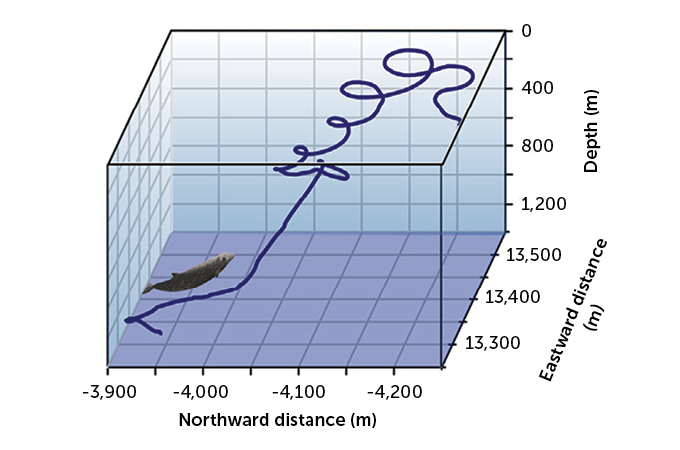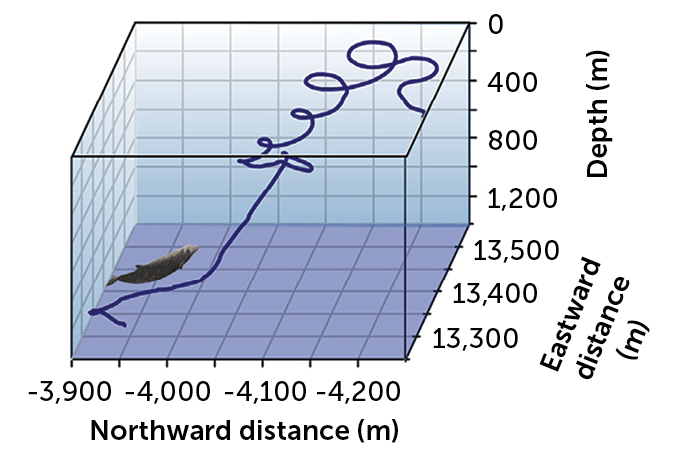This post was originally published on this site
Marine science has its own crop circle mysteries. Sea turtles, sharks, penguins and even whales sometimes just go circular, swimming around and around in a loop or spiral. The puzzles are not whodunits so much as whydoits.
“I doubted my eyes when I first saw the data,” says marine biologist Tomoko Narazaki of the University of Tokyo. A green sea turtle (Chelonia mydas) she and colleagues tagged near an African island with good places for laying eggs made a total of 26 circles. The turtle turning and turning underwater swam “like a machine,” Narazaki says.
When Narazaki got home and enthused to her institute colleagues, she found that they had recorded circling or spiraling bouts now and then in other marine animals. Going back more than a decade, 3-D data-logging devices fastened on 10 sea species as diverse as king penguins and a Cuvier’s beaked whale had picked up enough detail to reconstruct the animals’ circles and squiggles, Narazaki and colleagues report March 18 in iScience.
It’s easy to imagine what’s going on with some of the swimmers: Tiger sharks (Galeocerdo cuvier) looping around during the deep phase of their plunges to depths near the Hawaiian Islands are probably circling in search of prey. Other researchers have found humpback whales whooshing around creating circular death traps of bubbles that keep prey in a dense, gulpable mass (SN: 11/9/19). But some acrobatics get more mysterious.
The green sea turtle that amazed Narazaki was circling steadily — no lunges or exploratory side-loopings —so the researchers doubt the animal was looking for food. Narazaki saw this behavior while tracking a turtle that researchers had moved off-course on its way to lay eggs. The turtle didn’t swim bouts of repeated circles until near the inviting island. That circling may have had something to do with getting a good read on an important location, perhaps checking the geomagnetic field, the researchers propose. They note that submarines also circle as they take geomagnetic data.
“This might be similar to what humans often do when hiking through wilderness,” says Kenneth Lohmann, at the University of North Carolina at Chapel Hill. When turning off a path, we often take a special look around the crucial spot so we can retrace our steps. Lohmann has studied direction finding in hatchling sea turtles, and can imagine the adult green turtles checking not just the magnetic field, but a variety of location clues including chemical traces and sounds.
One of the new paper’s more puzzling curled paths followed a Cuvier’s beaked whale (Ziphius cavirostris) coming up from a deep dive. Its route angled up in a relatively straight line from around the depths until roughly 640 meters from the surface. Then the whale started spiraling upward in wide curlicues.
Several possible explanations come to mind, says Sascha Kate Hooker, from the University of St. Andrews in Scotland, who studies dive physiology in marine mammals. In theory, deep-plunging whales could risk getting the bends if they swim upward too fast, she has calculated. A slower ascent, with loops, might reduce that risk.
Yet speeds vary so much in rising beaked whales there must be more than basic physiology in play, Hooker says. She’s convinced by other researchers that evading the killer whales matters a lot on these upward trips. A straight path can take the beaked whale a kilometer (horizontally) away from its starting point in the depths. So spirals might let the animal cover the distance upward and start looking for its companions without moving so far off. ‘I wonder if this relatively passive second half of the ascent, staying in the same spot, would help animals regroup,” she says.
King penguins (Aptenodytes patagonicus) don’t forage as deeply as beaked whales but do swim circles near the surface, Narazaki reports. If they’re circling rather slowly, they might just be preening their feathers, a vital task for maintaining insulation in Antarctic waters, says Manfred Enstipp of Hubert CURIEN Multidisciplinary Institute in Strasbourg, France, who also has studied these birds. If the penguins are circling fast though, the muscle activity might help them get blood flowing and warm up. So that’s another possible comparison with humans outdoors, stamping our feet to warm up on a winter’s day, maybe even turning in little mystery circles ourselves.


